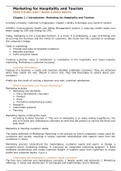Marketing for Hospitality and Tourism
Philip R Kotler, John T Bowen & James Makens
Chapter 1 // Introduction: Marketing for Hospitality and Tourism
In today’s industry: customer is king/queen. (reason // ability to damage your name or career).
EHSMS= Environmental Health and Safety Management System // reducing landfll waste and
water usage by 20% and energy by 10%.
Today marketing is not a business function, it is more. It is philosophy, a way of thinking and
structuring the business and the minds of customers. But never fool the customer or endanger
the company’s image.
Tasks in marketing:
o Provide real value to targeted customers
o Motivate purchase
o Fulfl consumer needs
Creating customer value & satisfaction is mandatory in the hospitality and travel industry
marketing. Marketing is customer focussed.
Customer Orientation
Purpose of a business = create and maintain satisfed, proftable customers. They are attracted
when their needs are met. (Result // return visit, they talk favourably to others about your
company)
Profts are the result of running a business very well, customer satisfaction.
What is Hospitality and Tourism Marketing?
Marketing includes
Marketing mix elements:
o Place (distribution channels)
o Product
o Price
o Promotion (advertising & sales)
Research
Information systems
Planning
Marketing means // hitting the mark.
According to Peter Drucker // “The aim of marketing is to make selling superfuous, the
aim is to know and understand customers so well that the product or service fts them and
sells itself.”
Marketing is meeting customer needs.
The books defnition of Marketing: Marketing is the process by which companies create value for
customers and society, resulting in strong customer relationships that capture value from the
customers in return.
Marketing process: Understand the marketplace, customer needs and wants Design a
customer-driven marketing strategy Construct an integrated marketing program Build
proftable relationships and create customer delight Capture value from customers to create
profts and customer equity. (Figure 1)
Understand the marketplace, customer needs and wants
The fve core customer and marketplace concepts: 1. Needs, wants and demands: 2. Marketing
offerings: 3.. aalue and satisfaction: 4.. Exchanges and relationships: and .. Markets.
, 1. Customer needs, wants, and demands
Needs // a state of internally felt deprivation. (hierarchy of needs, Maslow)
Wants // human needs take as they are shaped by culture and personality. How people
communicate their needs.
Demands // wants backed by buying power.
2. Market Offerings
Products to sell are not only tangible products but can also be services and experiences. Those
are more important in the leisure industry than tangible products. The aim is to sell memories.
3.. Customer aalue and Satisfaction
Customer value// difference between the benefts that the customer gains and the costs of
obtaining the product.
Costs can be monetary or nonmonetary.
Nonmonetary = for example time
Customer expectations // based on past buying experiences, opinions of friends and information
received on forehand. Meeting expectations means satisfed customers.
4.. Exchanges and Relationships
Exchange // the act of obtaining a desired object, by offering something in return (transactions).
.. Markets
Market // a set of actual and potential buyers of a product. They share a need or want.
Designing Customer-Driven Marketing Strategy
Marketing management // the art and science of choosing target markets and building proftable
relationships with them. Marketing Manager’s aim is to fnd, attract, keep and grow target
customers by creating, delivering and communicating superior customer value.
There are two questions that are important for this:
o What customer will we serve (target market)?
o How can we serve the customer best (value proposition)?
Selecting the target market = done by dividing into segments (market segmentation) and
selecting the aimed segment (target marketing).
Choosing a value proposition // benefts or values it promises to deliver to consumers. It is done
by answering the question: why should I buy your brand rather than a competitor’s? It should
give advantage in the target market.
Designing marketing strategies:
. alternative concepts: production, product, selling, marketing and marketing 3..0.
Production Concept
States that consumers will favour products that are available and highly affordable. Therefore,
management is focussing on production and distribution efciency (inward focus).
Product Concept
(inward focus) States that consumers will favour products that offer the most quality,
performance and innovative features. Management will focus on product improvements. Can
lead to marketing myopia // products can change entirely and so also change target markets.
Selling Concept
States that the customer only buys enough after large selling and promotion efforts. The aim is
to use sales and not to think about satisfaction after the sale.
Starting point= factory
Focus= existing products
Means= selling and promoting
Ends= profts through sales volume (fgure 3.)
Marketing Concept
A recent business philosophy. Aims that achieving organizational goals depend on determining
the needs and wants of the target markets.
Starting point= market
Focus= customer needs
Means= integrated marketing
Ends= profts through customer satisfaction (fgure 3.)
Marketing 3..0
, Concept developed by Philip Kotler, Hermawan Kartajaya & Iwan Setiawan. Instead of seeing
people as consumers, seeing them as human beings (they have a mind, heart and a spirit).
There are three major forces that shape a business landscape towards marketing 3..0:
o Participation and collaboration
o Globalization
o Creative society
Participation and collaboration:
Mainly caused by social media, customers participate (taking part in something) and collaborate
(working with someone) with each other and companies. Customers can take part in your
products and marketing by sharing and writing reviews. Which is not always positive of course, it
can also work against your company.
Globalization:
The world is connected due to the possibility to travel around the world quite easily. The
outcome= better understanding of other people and their cultures. But, people do face the
paradoxes of traveling as well. People maybe stay in a luxury hotel, while 2 streets away a kid
gets sold because the family is desperate for money. Companies can consider getting involved in
projects that support social, economic or environmental issues in the society as a marketing tool.
Creative society:
A marketing tool can be to develop healthier fast food restaurants or take the nature into
account while
developing a way to decrease waste around restaurants. This is not about public relations but
about weaving values into the corporate business.
For all those forces, it means: proft will result from customers’ appreciation of those companies
that contribute to human well-being and waste for example.
Concluded// The company’s marketing strategy outlines which customers the company will serve
and how it will create value for these customers.
Construct an integrated marketing program
The next step of the marketing process. It will actually deliver the intended value to target
customers. This is the part where the marketing strategy is transformed into action. Parts of this
phase are:
o Marketing mix
o Product= need-satisfying market offering
o Price= decide how much it will charge for the offer
o Place= make the offer available to target markets
o Promotion= communicate with target customers about the offer and persuade
them of its merits (excellence).
o Marketing tools
Building proftable customer relationships
This is the fourth and ‘most important’ step in marketing processes, building relationships. How
is a company able to develop strong customer relations? By applying one of the three value-
building tools:
Adding fnancial benefts (discounts)
Adding social benefts as well (serve the customers as individual human beings, know
their name, know their needs and wishes)
Add structural ties, fnancial and social benefts.
(table 1, page 21) Types of Customers.
Customer relationship management (CRM) is the most important concept of modern marketing //
managing detailed information about your individual customers & managing the tough points.
Goal= maximize customer loyalty.
Customer touch point // all the occasions on which a customer encounters the brand/product.
Example= website, billing, reservations, room service etc.





